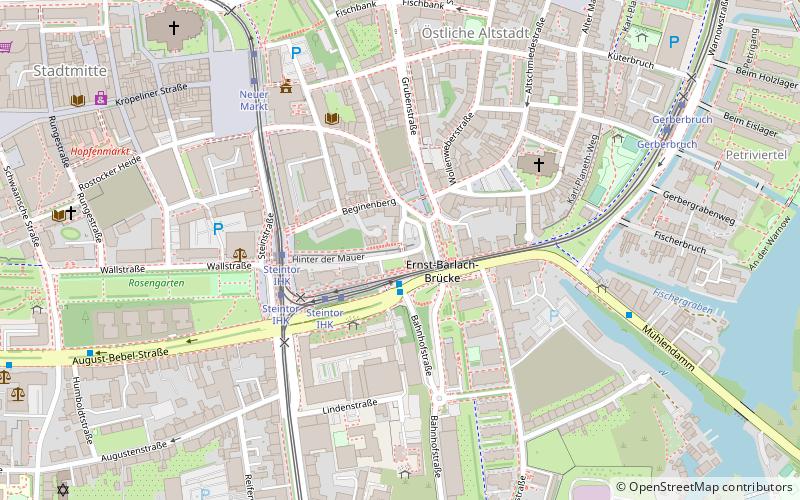Kuhtor, Rostock


Facts and practical information
The Kuhtor is not only the oldest of the still existing four of formerly 22 gates of the historic Rostock city fortifications, but also one of the oldest buildings in Rostock and probably the oldest preserved city gate in northern Germany.
In 1262, the early Gothic gate tower, which led to the road to Bützow and Werle, was first mentioned in a document, but very soon it was replaced by the Stone Gate as the most important sally port of the town to the south. Now only cattle were led through it to the Warnow meadows, which gave it its name.
The four-story defensive tower is 8 by 9 meters wide and has a wall thickness of 2 meters. The gate has a width of 3.5 and a height of 3 meters.
At the end of the 14th century the field side was walled up. Only in the period of the city's disputes with the sovereigns, which resulted in the First Rostock Treaty of Succession - when part of the fortification, including the stone gate and the tower on the Rammelsberg were demolished - it was reopened as a city gate. When the city council decided in 1608 to use it as a light prison, after the field side was closed again, the city side was closed as well.
The massive stones that were typical of the architecture of late medieval fortifications are still very visible today at the base and foundation of the cow gate. In addition, there are embrasures and indentations to which scaffolding was attached in the Middle Ages when repair work was necessary. In the event of war, these indentations could also be expanded into openings for battlements.
Later, the gate was made usable as a dwelling. Thus, the gunsmith of the city lived in it from 1671. In 1825 it was completely rebuilt into a residential house and after a while it was completely surrounded by houses. Until 1937 the town provided it to town servants, craftsmen and day laborers as a dwelling. It was only in 1938 that it was partially reconstructed, for example, on the field side the passage arch with the early Gothic pointed arch, the blinds, as well as the German band, but four years later it was badly hit by bombs. The roof truss was destroyed and the gate burned out completely. From 1962 to 1964 the building, which had remained covered until then, received its new roof. It was not until 1984 that it was completely reconstructed. From 1985 to 1990 it was the seat of the district board of the Writers' Association of the GDR. On November 9, 1990, the Literaturförderkreis Kuhtor e.V. was founded. Until 1993, however, the gate still belonged to the city's cultural office. From 1998 to 2000, it was fundamentally reconstructed and handed over again to the Literaturförderkreis e.V. for reopening. Until the end of 2009, the house then housed the Literaturhaus Rostock with the Literaturrat M-V e.V. as well as the Risse e.V. Since the beginning of 2010, it has been home to a private management consultancy.
Kuhtor – popular in the area (distance from the attraction)
Nearby attractions include: Petrikirche, Rostocker Hof, Marienkirche, Zoological Collection Rostock.
Frequently Asked Questions (FAQ)
Which popular attractions are close to Kuhtor?
How to get to Kuhtor by public transport?
Tram
- Steintor IHK • Lines: 1, 2, 3, 4, 5, 6 (3 min walk)
- Neuer Markt • Lines: 1, 4, 5, 6 (6 min walk)
Bus
- Steintor IHK • Lines: F1, F2 (3 min walk)
- Am Bagehl • Lines: 22, 23, F1 (5 min walk)
Ferry
- Schnickmannstraße • Lines: Fähre Gehlsdorf - Schnickmannstr (16 min walk)
- Kabutzenhof • Lines: Fähre Kabutzenhof - Gehlsdorf (34 min walk)
Train
- Rostock Hauptbahnhof (20 min walk)
- Rostock-Kassebohm (25 min walk)











